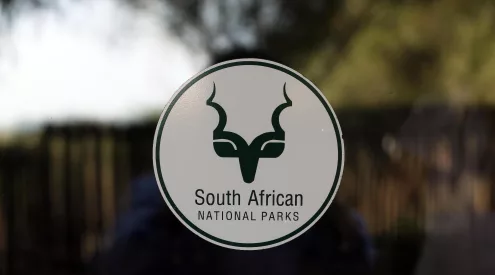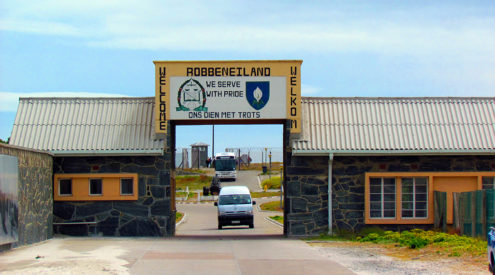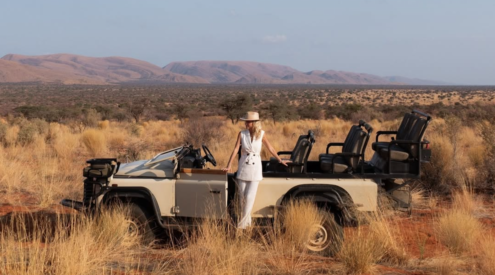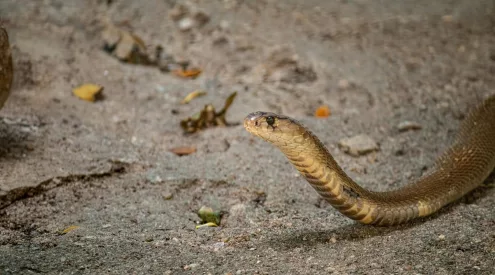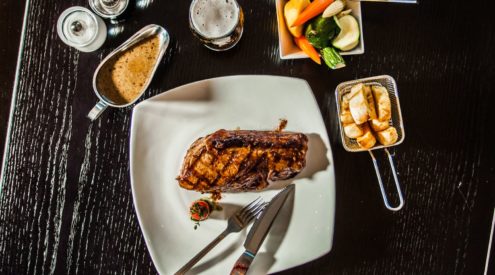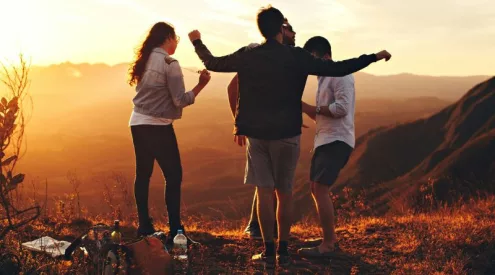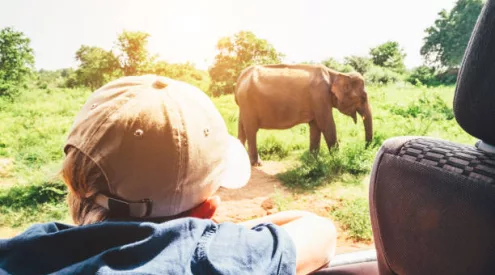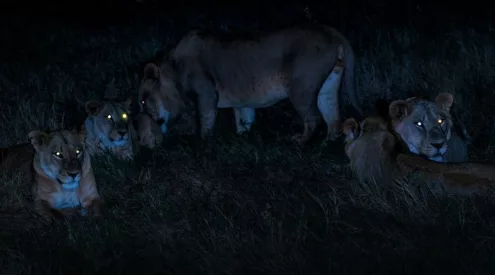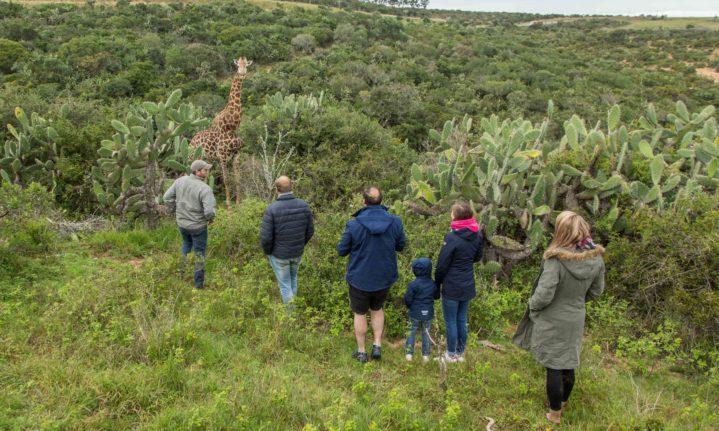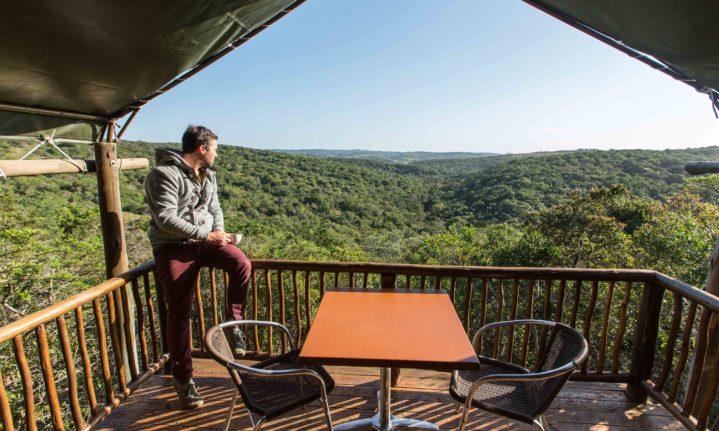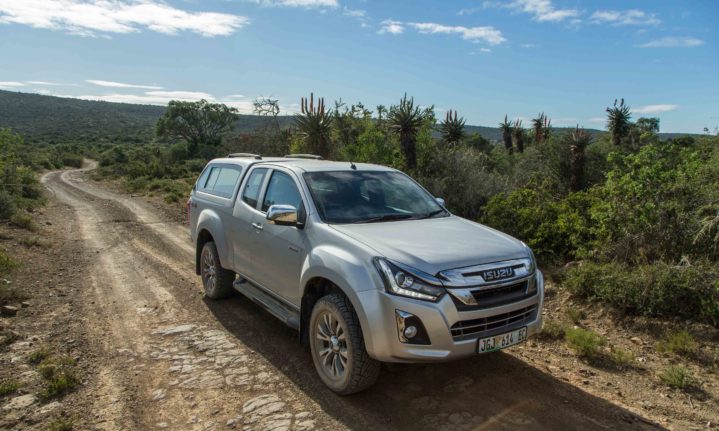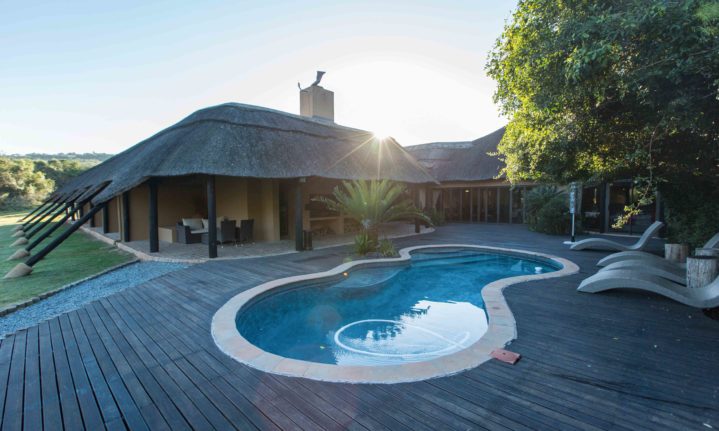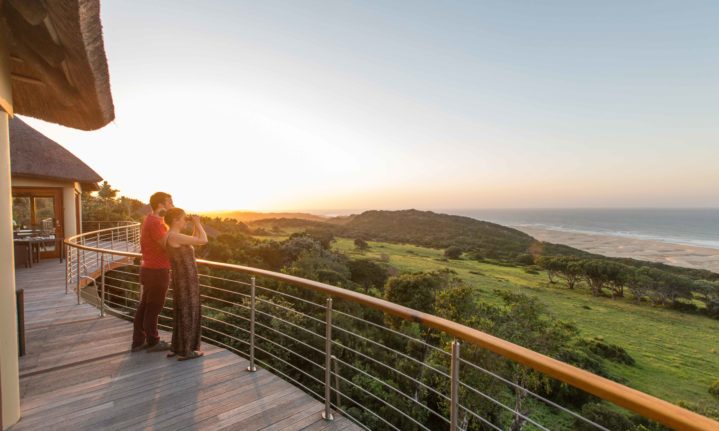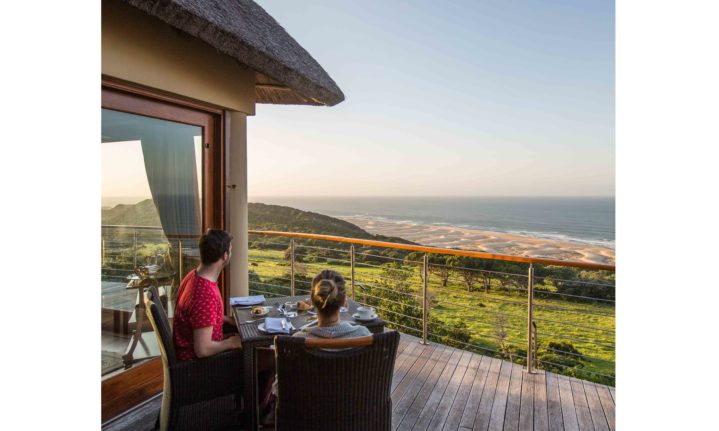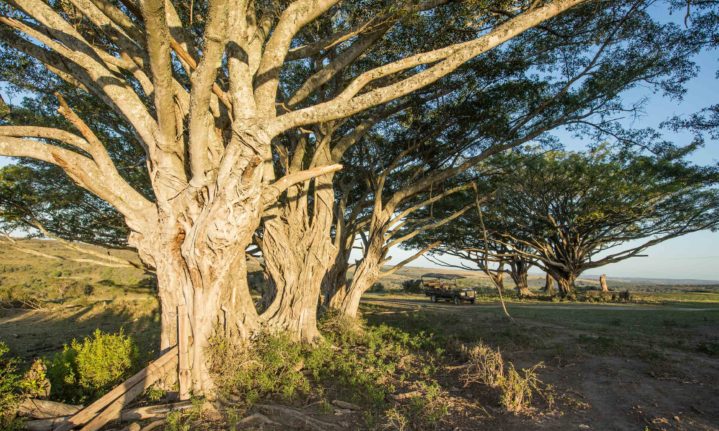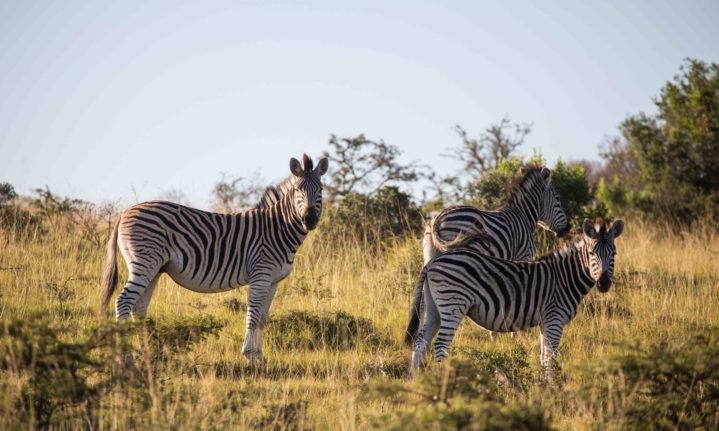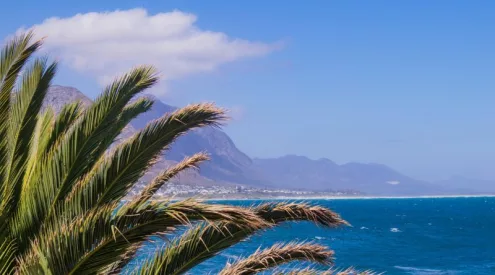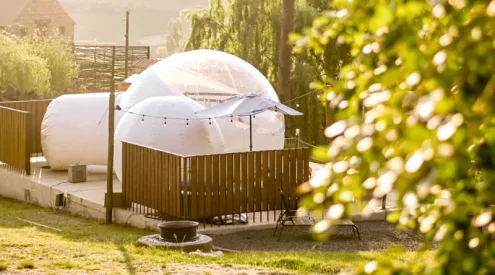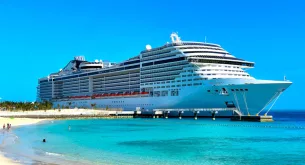When you think of game reserves in the Eastern Cape, Addo probably comes to mind first. But there’s way more to this biodiverse province than elephants. We set out to find the lesser-known parks where wildlife lovers can get their fix.
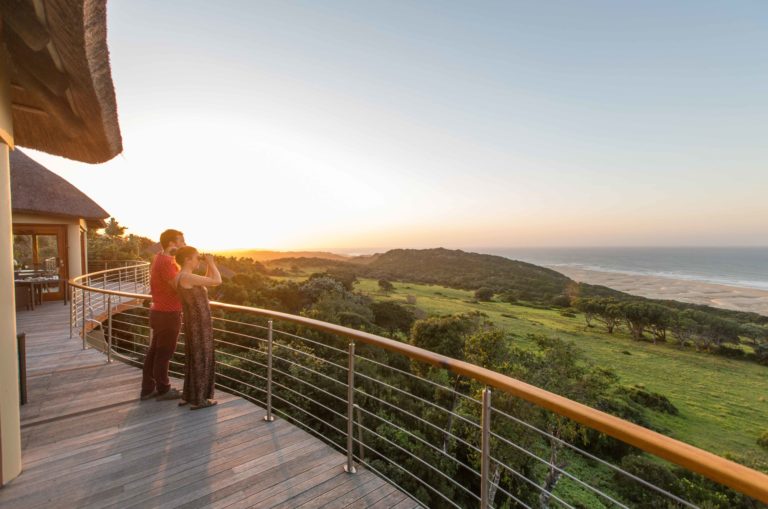
Oceana’s deck is the perfect spot for the unusual experience of watching game and whales at the same time. A telescope is available to see further out to sea, which is especially useful when the whitewater frenzy of the Sardine Run comes by.
To know the Eastern Cape is to love it – just ask anyone from that province. Hell, I’m only an occasional visitor and I love it. That became even clearer on this trip as I travelled through a land of spring hares and spekboom, aloes and aardvarks, where thicket meets ocean and beach dunes go on forever.
I kept clear of the Karoo and stayed relatively close to the coast between Port Elizabeth and East London. I crossed rivers with names like Great Fish, Sundays and Bushmans, and passed countless signs for Frontier and Xhosa monuments. Occasionally, I tuned into Algoa FM for local flavour (and the rest of the time I relied on Nanaga Farm Stall’s legendary pies).
I travelled in June when early winter rains had seen the drought-stricken province become blanketed in green grass, purple irises and yellow daisies.
All seven of the reserves I visited were farms that have been converted back into wilderness, all more than 20 years ago. It was encouraging to see how the ecosystem has been reinvigorated. The red-billed oxpecker, for example, has made a remarkable comeback in the area. While some are success stories, other reserves still have some work to do. All of them, however, are striving to conserve our wild areas and protect at-risk species. The biodiversity is impressive too, as many reserves boast five of the eight South African biomes – thicket, grassland, Nama-Karoo, fynbos and forest.
The standard of lodgings varied; some were affordable, while others might need some saving up for. All of them, however, come with a hearty dollop of Eastern Cape hospitality. Many also offer day trips, which is handy when you’re holidaying on the coast. Ultimately, if you visit, you too might develop a fondness that feels a lot like love for this wild backcountry. You’ve been warned.
1. Walk with giraffes
Bellevue Forest Reserve

There are no giraffes in Addo Elephant National Park, but visitors eager to see them can find some at Bellevue, a 30-minute drive away. Image: Matthew Sterne
‘You’d be surprised how tricky it can be to find the world’s tallest animal,’ guide Stefan Smith said as we entered the 450-hectare giraffe section of the reserve. We were near Paterson, in the foothills of the Zuurberg Mountains, which form a natural boundary with the Karoo. Dense thicket covers the rugged hills and the bumpy road made us shake like dancing puppets, but within 10 minutes we found the herd of six giraffes.
As we climbed out of the vehicle, the animals stopped chewing, leaves protruding from their mouths like country bumpkins. They stared at us accusingly, as if to say, ‘Who do you think you are, waltzing into our patch of Albany thicket?’
The 4,5m-tall bull took up a sentinel position between us and his family. He stood transfixed, his ears pointing in our direction. He lowered his head a couple of times as if trying to get to our eye-level. Stefan whispered, ‘He does that to size us up and gauge the nature of our threat.’
A moment later and the giraffes lost interest. The bush was quiet and all we heard was the sound of them munching. A study by the University of Vienna recently found that giraffes hum to each other at night, but that’s about it – during the day you won’t hear a peep from them vocally.
The curiosity of the younger giraffes overcame them and they trotted towards us for a look. They walked away. They bounded back. We were 20 metres from them, with bushes between us, and it felt different to viewing them from a car – there was a sense of connection on foot. Stefan and I admired their different patterns, quirky expressions and long eyelashes. After 15 minutes, they moved off and our time was up.
As well as giraffe, you might see zebra, impala, springbok, blesbok, nyala and eland in the reserve. Bellevue also offers guests the chance to visit a breeding herd of buffalo during their morning feed. It takes a maximum of 60 visitors a day, divided between morning and afternoon sessions.
Info: No self-drive. Giraffe walk R650 pp, buffalo feeding R450 pp.
Stay here: Olifantskop Lodge has a lounge, bar, dining area and veranda. A short walk through the manicured garden leads to five en-suite rooms. From R1 ,290 pp B&B (dinner can be provided). The rustic-luxury of Stargazer Camp is available in summer, sleeping just four people in tree glades. From R2,750 per person, including all meals, two game drives and walks. 0422351450, bellevueforest.co.za, olifantskoplodge.co.za
Tip: The morning giraffe walk ends with a delicious full breakfast on the deck at the lodge, but for the most amount of time with the giraffes, go in the afternoon (there’s a high tea beforehand). Those sessions tend to be longer as there’s no rush to get back and last about 90 minutes.
2. Best chance to see lions near Port Elizabeth
Schotia Private Game Reserve
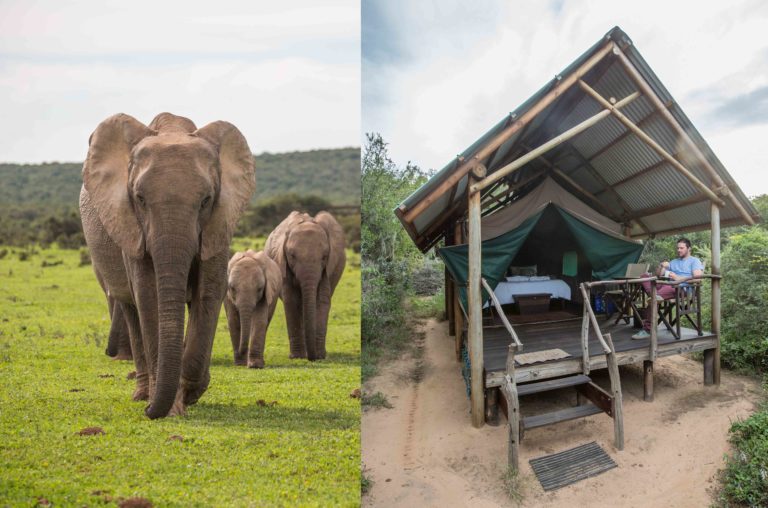
From left: A visit to Addo, in combination with Schotia, can be arranged; Visitors are given radios at the tented camp in case of emergencies. Image: Matthew Sterne
Our spotlight scanned the dark bushes like a mobile lighthouse. Night-wandering hippos were on our search list. The beam picked up animals to our right.
‘Over there is a bushbuck,’ said guide Zane Hagemann, ‘and behind it is a … that’s a brown hyena … and it’s hunting!’
Zane quickly swerved the Land Rover in the direction of the shaggy predator as it dashed through our headlights in pursuit of its prey. The bushbuck saw it too and set off. The race was on; the hyena was gaining ground when they both disappeared into the thicket. Zane turned off the engine and we listened. Silence. Eventually, he said, ‘Well, I haven’t seen that in a while.’
It was an exciting end to an eventful day – the sightings in Schotia came quickly as it has a wide variety of wildlife concentrated in a relatively small area. Bordering the south-east of Addo Elephant National Park, it’s a 1,600-hectare reserve of two parts. The southern section has elephant, giraffe, buffalo, hippo, antelope such as kudu, nyala and waterbuck – and that one brown hyena. The north is 600 hectares and home to three lions and a lesser density of game. (Schotia, the oldest private reserve in the Cape, was also the first in the region to have free-roaming lions.)
For those familiar with larger parks, the set-up might feel a little unnatural as the lions, for example, are highly accustomed to vehicles. For the uninitiated, however, the reserve offers intimate encounters with many different species – so much so that it can feel like a modern-day Noah’s ark.
Info: No self-drive. The game-drive experience with dinner and drinks costs from R2,000 per person.
Stay here: Orlando Outspan has three safari-tent camps (with outdoor showers) in their own cluster of bush in the lion section;Camp One has the best views. Family Lodge has thatched chalets that sleep four, each with a fireplace, but no electricity. Both options cost from R3,000 per person DBB, including three game drives. 0422351436, schotiasafaris.co.za
Tip: Most visitors come for the Tooth & Claw Safari that includes an afternoon game drive, hot drinks and roosterkoek in the old milking shed, a traditional SA dinner in the lapa and a short night drive.
3. Variety in a Big-Five reserve
Amakhala
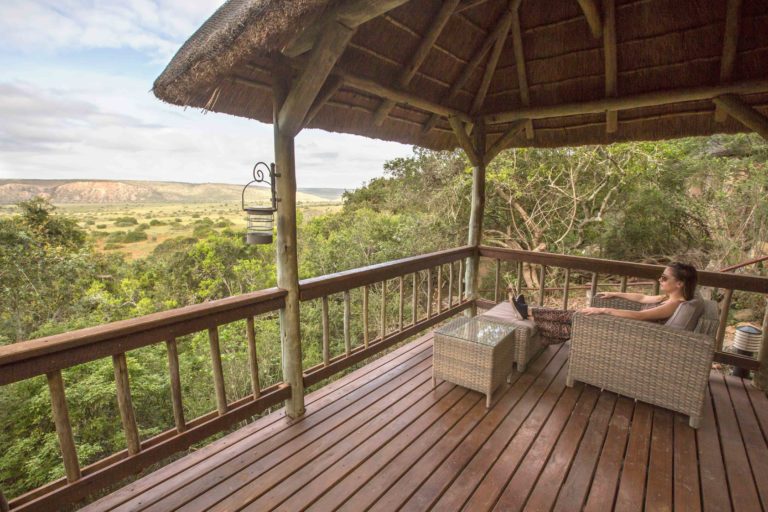
The private deck at Woodbury Lodge had splendid views and was surrounded by fireflies at night. Image: Matthew Sterne
There were signs the lions were nearby – fresh tracks in the sand, crows in the trees and jackals prowling in the vicinity. (Plus they had been seen in the area.) Our vehicle bounced slowly along and soon we spotted them 50m away, where the grass met the bush line. Our guide cut the engine and we spent the next 40 minutes watching the male lion fuss about near an impala kill, after the females had wandered away. A red sun rose behind us.
A mischievous black-backed jackal trotted onto the scene with unfounded confidence and began to harass the lion, while the crows grew animated and started doing fly-bys. We left but were soon called back on the radio as two wildebeest had wandered into the lion area, lost in the wrong neighbourhood, and the big cats had taken them down.
This was just one of many intimate sightings we had at Amakhala, an 8, 500-hectare reserve close to Addo and Shamwari. Others were giraffe calves gambolling comically alongside us, zebras sidling up to the vehicle, elephants blocking our path and buffaloes eyeballing us from just metres away. The landscape was striking too. Every sundowner and coffee spot granted us elevated views of a land moulded by the Bushmans River running through it.
Of all the reserves I visited, Amakhala has made the most progress towards returning the land to nature and reinstating wildlife. As well as the Big Five, there’s cheetah, giraffe, zebra and plenty of antelope species.
‘Amakhala is unique in that there are 9 owners,’ explained reserve manager Mark Palmer. ‘For this to last 20 years tells you of the inherently good hearts and intentions here. That’s spilled over into the commitment to conservation, the community and the guest experience.’
We met one of the owners, Bill Fowlds, in the bar at Leeuwenbosch Country House one night. He spoke of growing up in the area and how a bunch of neighbouring farms decided to drop their fences in 1999 and set about rewilding the land. A feisty character and born raconteur, Bill held us captivated with tales of the local cricket club, the nuances of isiXhosa and the early days of Amakhala. And strangely, even with all the great sightings, delicious food and impressive lodgings, it will probably be the people at Amakhala I’ll remember most fondly.
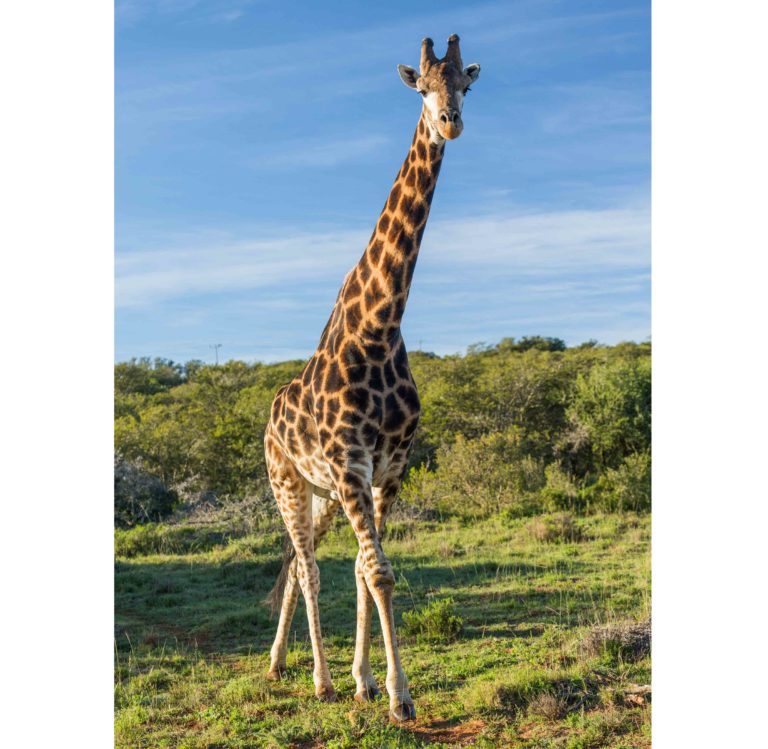
Giraffe was one of the original species reintroduced in 1999. Image: Matthew Sterne
Info: No self-drive. Day visitors can book a game drive and lunch from R1,200 per person.
Stay here: Amakhala offers three-, four- and five-star accommodation owned and managed by fifth-generation Frontier settler families. There are 10 options, made up of restored country houses, bush lodges and tented camps located in different parts of the reserve. From R2,120 per person sharing all-inclusive. 0414505658, amakhala.co.za
Tip: Summertime is most popular but winter, even with its cold mornings, holds a special charm. As it’s low season, you can spend more time at sightings.
4. Best viewpoint
Great Fish River Nature Reserve
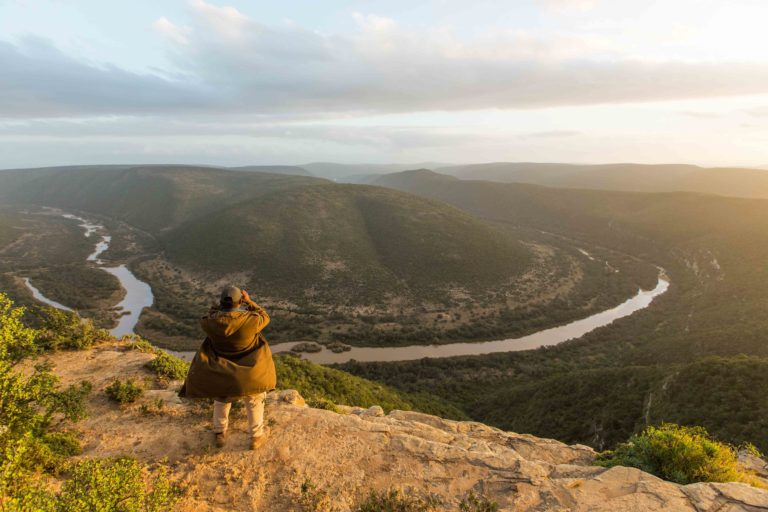
Sizwakele Mkhulise scopes out the Great Fish River from Adam’s Krantz viewpoint – although no-one is exactly
sure who Adam was. Researchers are busy delving into the past to learn more about the reserve’s history. Image: Matthew Sterne
The aloes cast long shadows across the dirt road as I drove towards Adam’s Krantz viewpoint. Arriving just before sunset, I met reserve manager Sizwakele Mkhulise and together we ambled down the wooden walkway. As the panoramic view of a lush gorge opened up before us, I may have let out a gasp. We stood more than 100m above a horseshoe bend, staring at the river coming down the valley, turning below us and flowing through the adjoining valley.
The sun was setting over the Amatolas and its final rays gilded the gorge in an amber light. A fish eagle soared past at eye level; a hippo harrumphed somewhere far below. I walked back and forth, taking the same photo over and over. ‘Man, we live in a beautiful country – how have I not heard about this place?’
Sizwakele chuckled and explained the lie of the land: ‘This reserve is comprised of three former reserves: Double Drift, Sam Knott and Andries Vosloo Kudu Reserve. We’re surrounded by 13 communities to the east, where many of the reserve’s employees come from, and farms to the west.’ Sizwakele took a moment to look through his binoculars at buffalo in the gorge.
‘The Great Fish River travels for 30km through the reserve and cuts it in two. It formed the border between the Cape Colony and Xhosa nation and many battles were fought around here during the Frontier Wars,’ he said. Today, visitors to this area – between Makhanda (Grahamstown) and Fort Beaufort – can see evidence of these battles in the graves and forts found at Double Drift, Wilshire and Botha’s Post.
There are nearly 100 kilometres of road but they only slice through a small portion of the mammoth 45,000-hectare reserve, home to the largest single tract of subtropical thicket in the country. ‘This is a core conservation area due to its significant plant biodiversity. We often send wildlife to other reserves in need of restocking and currently have just two elephants, but plans are in place to introduce 25 new ellies shortly.’
I went on one of the two game-drive circuits the next day and only saw kudu, zebra, ostrich and a huge herd of eland (the reserve also has hippo). But it’s the landscape and solitude that are the major attractions here.
Info: Self-drive game viewing from R96 per adult; guided drives from R191. Conservation fee R24 per adult.
Stay here: There are 68 self-catering beds altogether – at Mbalala Lodge (built by early settlers), Nottingham Lodge (a farm-style abode for a bigger group), Mvubu Lodge (stone cottages) and Mvubu Chalets. I’d recommend the latter for the setting on a ridge above the river; each has a balcony with braai area, plus there’s a pool. Number 10 has the best views. From R220 per person sharing. 0437054400, visiteasterncape.co.za
Tip: Guests can experience this landscape best on the Mvubu Trail, a guided one- or two-day hike that follows the river and takes in rock-art sites in caves. R112 per person per day.
5. Best place for romance
Oceana

Bontebok have found a new home in the reserve away from their stronghold of the Southern Cape. Image: Matthew Sterne
‘I never want to leave,’ my girlfriend said as we walked around our beach-facing suite. A four-poster bed stood in the centre, his-and-hers bathrooms flanked the room, a cabinet at the foot of the bed housed a TV that rose out via remote control like a crown jewel, and outside was a wraparound deck big enough to host a family braai. As impressive as the suite was, the 180-degree view of the reserve was the showstopper.
A grassy field, dotted with wildebeest and impala, stretched towards the sea.
Oceana is a 750-hectare reserve near Port Alfred, bordered by the Indian Ocean on one side and the R72 on the other. ‘This is not a game lodge,’ general manager Chris Roberts explained. ‘We’re a boutique-hotel experience with the added benefit of wildlife and beach.’
The animals are an eclectic mix of bontebok, black impala, giraffe, waterbuck, zebra and what they believe is the southernmost herd of sable in the world. On our afternoon drive, we saw huge splashes
out at sea – whales at play, we realised on closer inspection.
Then there’s the beach. Oceana has seven kilometres of private access to the shoreline (the beach is 13km long, from the Riet River to Port Alfred). We had sundowners on a beach deck overlooking
the wild ocean. There wasn’t a person or footprint in sight.
‘This is a place for special occasions and anniversaries,’ said Chris back at lodge. ‘We do a lot of small things, which makes a big difference on the romance side. But it’s also very relaxed. You can come in, take off your shoes and put your feet on the bar if you want. Our philosophy is we’ll go the extra mile to give you something unique and different.’
And what are those small touches? Well, there’s the bubble-bath menu (choose between avo and cucumber, bergamot and mandarin, or lemon verbena and fynbos), which the staff will prepare for you during dinner. There’s also breakfast in bed, special couples spa-treatment packages, a mobile gin bar and beach picnics. And, as you might expect from a five-star hotel, the food is excellent, full of creative touches and mouth-watering combinations that match the aesthetic. A few hours into our stay, I decided I also never wanted to leave.
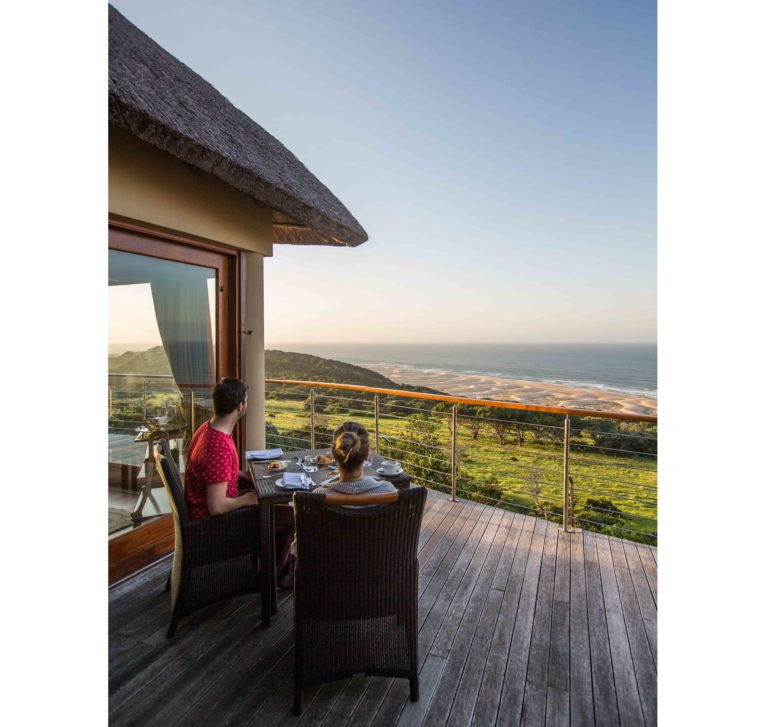
It’s all about the sunrise at Oceana – from the main deck while wildebeest stroll by. Image: Matthew Sterne
Stay here: There are four freestanding ocean suites, three lodge suites (also with sea views) and a private house with three bedrooms and its own plunge pool – all five-star stunning. The main lodge building has a large deck, bar, games room for adults and a pool. From R2, 600 pp, including all meals and game drives. 0435550305, oceanareserve.com
Biodiversity champions: Two of the places I visited, Oceana and Amakhala, form part of Indalo – an association and collaboration of 10 private game reserves, covering 68, 075 hectares and protecting more than 88 species of threatened or endangered plants and animals. It’s a fragmented area as the reserves are not all connected, but the long-term, blue-sky vision is to link them up and make one mega park that would rival the size of Kruger. Indalo strives for sound ecological management and biodiversity-based eco-tourism, and was recently declared a ‘Protected Environment’ under the Eastern Cape Biodiversity Stewardship Programme. indaloreserves.com
Tip: Have a tapas-style picnic on the beach. Staff will drive you down (you can’t walk due to the presence of buffalo) and leave you alone to dine in private for a few hours.
6. A game drive on East London’s doorstep
Mpongo Private Game Reserve

Mpongo’s River Lodge is the best place to stay for solo travellers and small groups. Image: Matthew Sterne
In the 1980s, a pineapple farm 35km from East London had its trees taken out to make way for the reintroduction of wildlife. Today, Mpongo, named after the river that runs through it, has four lodges and a restaurant next to a waterhole, and offers guided bush walks, bush picnics and game drives.
We saw eland, impala, wildebeest, zebra, giraffe, red hartebeest and blesbok on our drive through the hills of the reserve. Elephant and buffalo are also present, though I didn’t see them. Martial eagles, jackal buzzards and fish eagles are often spotted.
At the entrance of the 3 ,500-hectare reserve, there are 23 lions in six fenced enclosures. This is an unsettling sight, but they’re not there for show.
‘Most of these are rescue lions. Some came from a circus, others from breeding farms,’ said Martin Jansen van Rensburg, Mpongo’s general manager and an honorary Green Scorpion. ‘The plan is to move about six lions into a 150-hectare area (see box below right) and slowly get them up to hunting on their own again. We’d need to sell the others, but the market is difficult at the moment. Very few people are interested in buying lions.’
This is not the only plan Martin has for Mpongo’s future. He’d like to build an outdoor spa, a zipline, a tented camp and an eco estate. ‘There will be one house on each five-hectare stand so you won’t be able to see your neighbours. It’ll be off the grid and have no fences.’ A project like that, Martin says, will be able to free up funds to expand the property, introduce species such as hippo and add more buffalo and waterbuck.
As it’s just half an hour from East London, most people come here for a game drive and a meal at the Huberta Restaurant, which is named after the famous hippo who walked all the way from St Lucia to East London over three years in the late 1920s.
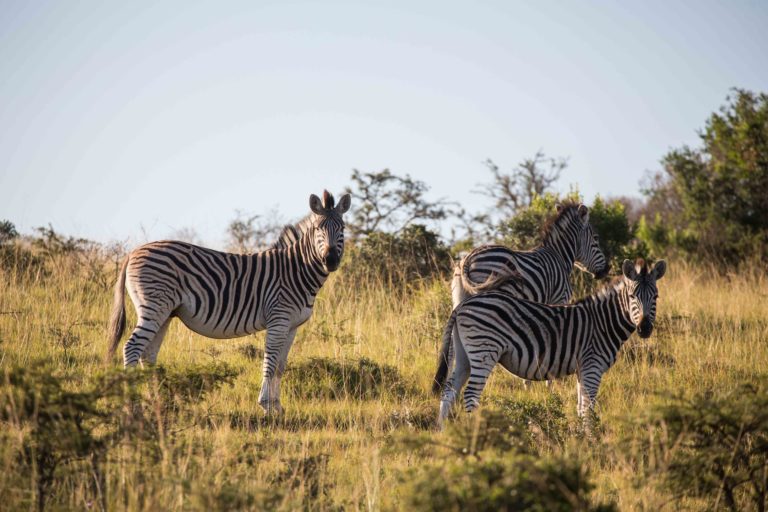
Zebras are common in the reserve. Image: Matthew Sterne
Info: No self-drive. Two-hour game drives from R484 per person., bush walks R280 per person. Picnics for larger groups only.
Stay here: Of the four options at Mpongo, River Lodge is the best, with 10 rooms, a luxury suite and three chalets. It’s the most comfortable and has the best amenities, with a pool, lounge and dining area, plus warthogs and ostriches pottering on the lawns. From R670 pp sharing (bed only); kids under 16 stay and eat for free. Umthombe Bush Villa is an old farmhouse with five bedrooms, ideal for a large group. R11,300 per night for 10 people DBB. 0437055000, premierhotels.co.za
Why have lion enclosures? Lions, along with elephants, are the hardest animals to manage in a reserve as their introduction can have serious and costly repercussions in terms of their effect on the environment and other wildlife. Many of these reserves are simply too small to maintain free-roaming lions – but for a game park to survive and be competitive, the belief is it needs to have lions. Owners have to make the decision on what’s feasible as different reserves have different circumstances and financial means.
7. Safari near the seaside
Inkwenkwezi
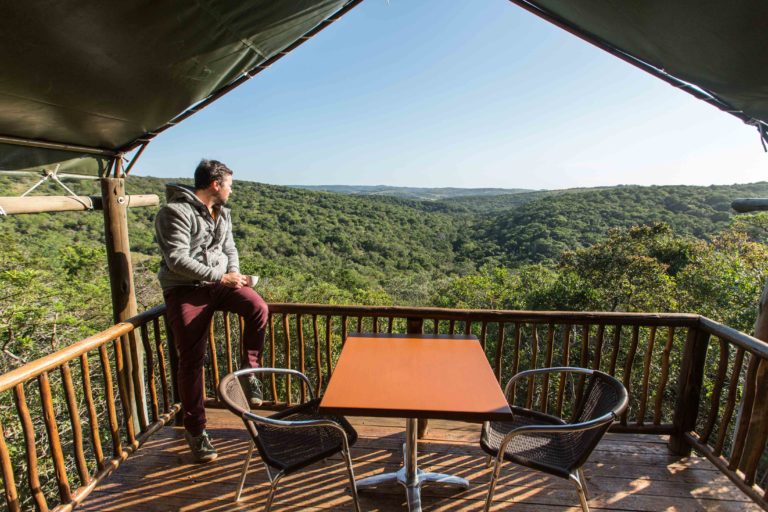
The deck views from the Bush Camp were my favourite feature. Image: Matthew Sterne
Inkwenkwezi, which means ‘under the stars’ in isiXhosa, took its initial steps in 1983 when the first of several farms was purchased near Chintsa, north of East London. In 1999, after 16 years of building up
a population of various species, Inkwenkwezi, led by Umtata-born brothers Graham and Keith Stanton, opened its doors.
Today the 4 ,500-hectare reserve has a number of unique drawcards. It’s home to the second-largest population of the endemic Umtiza listeriana tree, with more than 300 trees in a one-hectare area. (Only the Umtiza Nature Reserve on the other side of East London has more.) Secondly, a rare, cycad-feeding moth called Veniliodes setinata has been spotted in the reserve; there are only four places in the world where it still occurs. Thirdly, Inkwenkwezi has white lions. Sightings of these rare cats are pretty much guaranteed as they have their own 100-hectare enclosure (see box opposite).
On game drives, the ocean occasionally comes into view (the beach is 7,6kms away). As well as the lions, we saw giraffe, buffalo, blesbok, impala, zebra, wildebeest and nyala. Birdlife includes long-crested eagles, grey-crowned cranes and narina trogons.
There are two rivers in the reserve and guests can take a two-hour canoe trip in a tidal estuary, which is protected from the ocean by a sandbank so the waters are often calm.
Despite the wonders of the landscape, the lodge was one of my favourite features, with a view of the valley thicket from its elevated deck. Hearty buffet meals are served here three times a day, under high thatched roofs, and the lounge is the perfect spot to unwind after exploring the reserve. And the show’s not over: cheeky vervet monkeys lurk in the trees and dash inside to steal sugar and snack on it like popcorn-munching movie-goers, while nyalas promenade along the pathways.
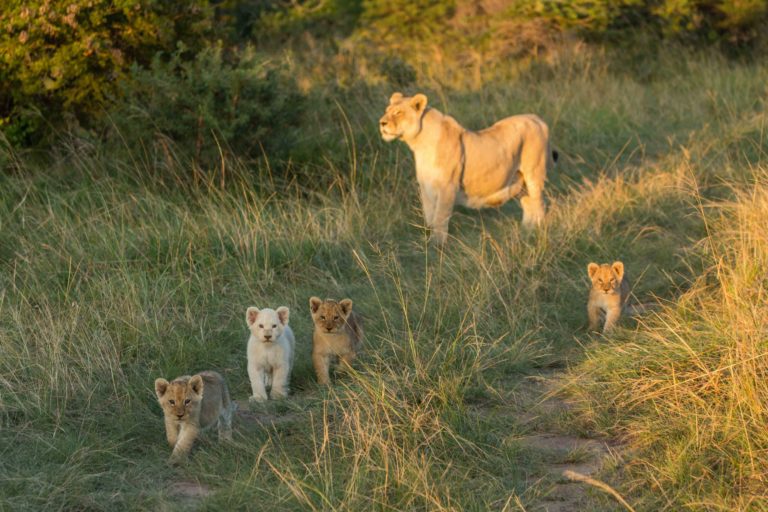
Inkwenkwezi Private Game Reserve is home to a number of white lions, such as this curious four-month-old venturing out with its siblings. White lions are not albinos – they owe their unusual colour to a recessive gene. Image: Matthew Sterne
Info: No self-drive. Guided drives from R985 per person. Canoe trips R450 per person. Forest hike from R100 per person.
Stay here: There are two camps, each with six en-suite safari tents on raised decks. Bush Camp is on a hillside while Valley Camp is surrounded by trees and a bit more luxurious and spacious, with air con and slipper baths. From R1,645 per person all-inclusive. 0437343234, visitbuffalocity.co.za
Tip: End your bush holiday by adding on a few extra days in the quiet seaside villages of Chintsa or Morgan Bay.

For this assignment, I drove the hardy Isuzu D-MAX 4×4 Extended Cab, the next evolution of the Isuzu KB. It has a luxurious interior with a slick look and a range of driving modes made for South African conditions. Its new features include Bi-LED headlights with LED daytime running lights, a colour-coded radiator grille, chrome front fog-lamp bezels and exterior side mirrors, a convenient sliding rear window and 16–18″ alloy wheels. With a six-speed intuitive transmission, it positions itself as one of the leaders in its class in both fuel efficiency and torque. From R521,500. isuzu.co.za

